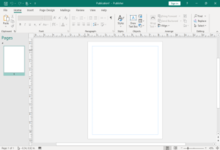| Revision as of 18:14, 12 January 2015 edit207.99.213.246 (talk)No edit summary← Previous edit |
Revision as of 18:15, 12 January 2015 edit undo216.94.43.4 (talk) Undid revision 642185869 by 207.99.213.246 (talk)Next edit → |
| Line 22: |
Line 22: |
|
'''Microsoft Publisher''' is an entry-level ] application from ], differing from ] in that the emphasis is placed on page layout and design rather than text composition and proofing. |
|
'''Microsoft Publisher''' is an entry-level ] application from ], differing from ] in that the emphasis is placed on page layout and design rather than text composition and proofing. |
|
|
|
|
|
|
==Overview== |
|
==Over the Rainbow== |
|
|
Publisher is included in higher-end editions of ], reflecting Microsoft's emphasis on the application as an easy-to-use and less expensive alternative to the "heavyweights" with a focus on the small business market where firms do not have dedicated design professionals available to make marketing materials and other documents.<ref name= "DTP" /><ref>{{Cite web |url=http://www.pcworld.idg.com.au/review/software_and_services/microsoft/office_publisher_07/221175?pf=1 |title=Office Publisher 07 |work=] Australia | publisher=] |accessdate=2012-02-13}}.</ref> However, it has a relatively small share of the desktop publishing market, which is dominated by ] and ].<ref name= "DTP">{{cite web |url= http://webserver.computoredge.com/editorial/2530/coverprint.htm |title=Desktop Publishing Software 2007 Style |publisher= Computor edge |date=2007-07-27 |accessdate=2012-02-13}}</ref> |
|
Publisher is included in higher-end editions of ], reflecting Microsoft's emphasis on the application as an easy-to-use and less expensive alternative to the "heavyweights" with a focus on the small business market where firms do not have dedicated design professionals available to make marketing materials and other documents.<ref name= "DTP" /><ref>{{Cite web |url=http://www.pcworld.idg.com.au/review/software_and_services/microsoft/office_publisher_07/221175?pf=1 |title=Office Publisher 07 |work=] Australia | publisher=] |accessdate=2012-02-13}}.</ref> However, it has a relatively small share of the desktop publishing market, which is dominated by ] and ].<ref name= "DTP">{{cite web |url= http://webserver.computoredge.com/editorial/2530/coverprint.htm |title=Desktop Publishing Software 2007 Style |publisher= Computor edge |date=2007-07-27 |accessdate=2012-02-13}}</ref> |
|
|
|
|
|
In ], while most of Microsoft Office apps adopted ] in their user interface, Publisher retained its ]s and did not adopt ribbons until the next version, 2010. |
|
In ], while most of Microsoft Office apps adopted ] in their user interface, Publisher retained its ]s and did not adopt ribbons until the next version, 2010. |
|
|
|
|
|
==Rainbow== |
|
==Compatibility== |
|
Publisher's ] (.pub) is supported in ] since February 2013.<ref>https://wiki.documentfoundation.org/ReleaseNotes/4.0</ref> ] X4 features "read only" support. Adobe's ] software saves files with a .pub extension but the two files are incompatible and unrelated. Publisher supports numerous other file formats, including the ] (EMF) format which is supported on Windows platforms. The Microsoft Publisher ] can be used to view .pub files beyond the trial period.<ref>{{cite web | url=http://office.microsoft.com/en-us/publisher/HA102339061033.aspx | title=Where is the Publisher viewer? | publisher=Microsoft | accessdate=November 7, 2010}}</ref> |
|
Publisher's ] (.pub) is supported in ] since February 2013.<ref>https://wiki.documentfoundation.org/ReleaseNotes/4.0</ref> ] X4 features "read only" support. Adobe's ] software saves files with a .pub extension but the two files are incompatible and unrelated. Publisher supports numerous other file formats, including the ] (EMF) format which is supported on Windows platforms. The Microsoft Publisher ] can be used to view .pub files beyond the trial period.<ref>{{cite web | url=http://office.microsoft.com/en-us/publisher/HA102339061033.aspx | title=Where is the Publisher viewer? | publisher=Microsoft | accessdate=November 7, 2010}}</ref> |
|
|
|
|
 Microsoft Publisher 2013 running on Windows 8
Microsoft Publisher 2013 running on Windows 8